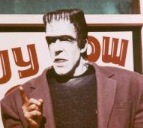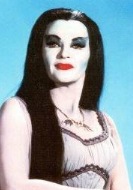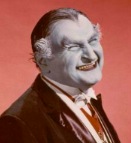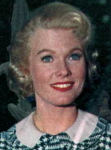

Rumor has it that the origins of "The Munsters" go as far back as 1943. Bob Clampett, who created the Beany and Cecil cartoon, thought up a TV show he called, "The Monster Family." By 1945, the whole thing was developed. The ideas were supposedly taken to Universal Studios and Clampett never heard of them again.
The actual Munster episodes and movies are credited with being created from a scenario by Chris Hayward and Allan Burns. Joe Connelly and Bob Mosher, the creators, writers and producers behind "Leave it to Beaver," got the script Hayward and Burns turned in. Norm Liebmann and Ed Haas were hired to develop the show, with Connelly and Mosher in charge.
The first outcome of all this collaboration was the color Munster pilot, entitled, "My Fair Munster." It was directed by Norman Abbott (Bud Abbott's nephew) and starred Fred Gwynne and Al Lewis as Herman and Grandpa. Joan Marshall played wife Phoebe, and Happy Derman played Eddie. Beverley Owen donned a blonde wig and played Marilyn. Most were amazed that the filming and editing became completed. The color pilot was restruck in black and white for distribution and eventually CBS bought the show. A third pilot was made, with Yvonne De Carlo stepping in as Lily, and Butch Patrick as Eddie, which was later heavily used in promotion for the new series. By April 1964, the Munsters we all know and love, had been created.During the series's run from 1964 to 1966, each episode was filmed with only one camera. As there was no studio audience to contain, it was possible to only need one camera to get various shots during a scene. One episode was filmed per week, with 38 the first season and 32 the second season. For 70 episodes, "The Munsters" aired and during its first season, garnered 18th place in the ratings. In 1965, it was nominated for a Golden Globe for "Best TV Show." Jack Marshall was also nominated for a Grammy for "Best Instrumental Composition (Other Than Jazz)" for the Munsters theme song.
History Timeline
1943-1945, the Munsters originate. early 1964, Bob Mosher and Joe Connelly pick up an idea to create a show based on a scenario by Chris Hayward and Al Burns. pre-April 1964, color pilot is filmed is of Munsters. pre-April 1964, Yvonne De Carlo and Butch Patrick are brought into the show. April 1964, CBS and "The Munsters" were together, and the series would air in fall of 1964. September 24, 1964, 7:30 PM, CBS, the Munsters' first episode airs, "Munster Masquerade." December 17, 1964, Beverley Owen's last episode airs ("Family Portrait") as she leaves to New York to get married. December 24, 1964, Pat Priest's first episode as Marilyn Munster airs. September 16, 1965, "The Munsters" second season begins. May 12, 1966, "The Munsters" last first-run episode airs, after being canceled. Summer, 1966, Munster, Go Home! is released in US theatres. Pat Priest is replaced by Debbie Watson as Marilyn. September 1, 1966, the last prime time episode of "The Munsters" airs on CBS October 27, 1973, "The Mini-Munsters" premieres on ABC's Saturday Superstar Movie. It is a cartoon version of "The Munsters." Al Lewis supplies the voice of Grandpa. February 27, 1981, The Munsters' Revenge airs. It is a TV-movie with Fred Gwynne, Al Lewis, Yvonne De Carlo, Jo McDonnell (as Marilyn), K.C. Martel (as Eddie), and Sid Caesar. Fall of 1988, "The Munsters Today" TV series premieres. It is based on the original series. It stars John Schuck as Herman, Lee Meriwether as Lily, Howard Morton as Grandpa, Hilary Van Dyke as Marilyn, and Jason Marsden as Eddie. 1991, "The Munsters Today" leaves the airwaves of syndication. October 31, 1995, a new Munster movie airs, Here Come the Munsters. It airs on the Fox Network. December 1996, a second Fox Network movie airs. It is entitled The Munsters' Scary Little Christmas. "The Munsters" Premise
from a 1960s CBS press release
Mockingbird Lane is a lovely, elm shaded street, winding gently through a peaceful suburban community where average families lead normal lives and concern themselves with the larger issues of the day, such as Little League standings. The homes along Mockingbird Lane are little islands of security, lawns are well manicured, and the houses almost seem to smile as they bask in the warm sunshine knowing that mortgage payments are being faithfully paid.
However, one house there is regarded by many residents in the neighborhood as a never healing scab in the community. This particular house, number 1313 to be exact, looks as thought it had been thrown from a speeding car or dropped from a high flying plane. Its architecture is Victorian and it hasn't been touched by a paint brush since the last nail was driven into place. Shutters hang askew, weeds grow with wild abandon, and vultures (some Egyptian) build nests in the barren trees. This Victorian horror, towering two stories and with a dungeon in the basement, houses the funniest collection of people ever to set up housekeeping. They are of course, the Munsters!
The head of this horrifyingly funny household is Herman Munster. Tall, gaunt, cadaverish and in his 150s. He has a flat square shaped head, a jagged saber scar on his forehead, ill-fitting clothes, darkly ringed eyes, and bolts in his neck. Herman looks at the world with loving eyes. A gentle soul, he has the trust of a child.

Fred Gwynne as Herman
His wife, Lily Munster, is hauntingly, and vampirishly, beautiful and almost as pretty as the day she died. A typical suburban housewife, Lily is concerned primarily with keeping her family happy and well fed. She can't seem to make friends with the other neighborhood housewives, though.

Yvonne De Carlo as Lily
That's just as well, as Herman and Lily have their hands full with Grandpa Munster. Grandpa is around, um, well, let's just say he's old. He is a great practical joker, but time has dimmed his memory. He is quite unpredictable.

Al Lewis as Grandpa
Herman and Lily have a son named Eddie. He has pointed ears and fangs. He loves to carry around his Woof-Woof doll. He thinks Grandpa's tricks are "neat." He is kind of half wolf boy, half vampire.

Butch Patrick as Eddie
The whole clan lavishes their attention on Marilyn Munster. They feel she is unfortunate in having a creamy complexion, rosy cheeks, blonde hair, and blue eyes, the all American college girl image. Marilyn has live with her Uncle Herman and Aunt Lily since she was a baby. She has an idealized picture of them, and sees them as normal as normal is. She feels she is the weird one, like they do. The whole clan is very protective of Marilyn, no matter how ugly she is.

Beverley Owen and Pat Priest as Marilyn
These five, are the Munsters. They look rather strange, act a little odd at times, but who's perfect? They also have the Koach and Grandpa's Drag-u-la racer in the garage. Normal, or what?
The Munster go about their day to day life freaking people out. Their telephone is in a coffin in the wall. They eat some normal foods like oatmeal, and sandwiches, but sometimes they eat some things more classy, like filet of dragon. To Lily, dusting the house means throwing dust around. For Eddie, it's too early for bed if it's too dark out. The Munsters also do lots of things backwards. Pour a cup of cream, and add some tea. Their house has cobwebs galore, yet they don't seem to mind.
Since 1964, The Munsters have remained a cult classic, and continue to gain new audiences and age groups, as they are repeated internationally in syndication.
SOURCES
Cox, Stephen. The Munsters Television's First Family of Fright. Contemporary Books, Chicago: 1989.